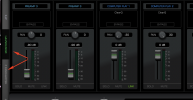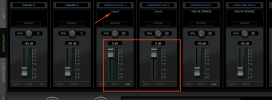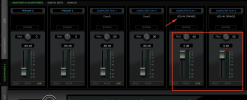Its Dec 2021....so I am posting from this as a brand new device, with the current firmware etc...Ive also read the old posts and was concerned and can only post my own experience.
1) user first impression
It loaded up extremely easy with my pc, the Launcher was smooth and the unit was playing my audio files quickly, in minutes.
Soon I was plugging in a guitar and it was recording to the DAW. Then added and tested briefly the RealTime PlugINs...eq, compressors, reverbs.
Then I started pulling up my audio files...44.1, 48,88,192,96 etc...and trying out my Sennheiser HD280 64ohm, TAKSTAR 671 120ohm, Beyer880Pro 250ohm headphones.
2) blowing the ears out and other Volume related thoughts...
The 250ohm required sliding the Mixer to 0db and the Headphone amp "large knob" to max also and it was a safe pleasent volume, clarity and very enjoyable. The 120ohm Takstar671 then allowed more gain and I backed off the volume on the "big volume" knob, smooth and excellent sounding, imo. Then the closed back SennheiserHD280 I use for tracking music and preventing bleed into the microphones....at 64ohm was really loud and theres much more gain than anyone should be using for extended periods of time unless they want ringing-ear hangover.
3) how does this stuff work?
Im not familiar with the clocks, sample rates and converter designs , filters etc....but I am comparing to my old interface that fed a max 24/96k via a rcacoax SPDIF to a GraceDesign headphone amp that was louder and could take 600 ohm headphones, and had more gain for even my 250ohms that I wouldnt go past 50% center with volume knobs.
One thing I miss for gear-head reasons only is my previous setup, when I played a Mozart file at 44.1khz the Grace Design LED for 44.1 lit up....if I played a 96khz music file the Grace Design detected that and would switch the LED to light up 96K green LED.....
The ZEN GO doesnt do this automatically as Im trying to figure out why not?
I can feed the ZEN GO with the same old interface SPDIF and the ZENGO display will change rates on the display, but only if I do it myself in the audio setup .....in other words it doesnt read the music file pcm? and light up the various sample rates automatically? I would really like the display to show the audio file PCM/sample rate according to the file automatically like my old Grace Design headamp did.? Ill keep searching...
4) subjective sound bliss
Now comparing to the "sound" preference the ZEN GO sounds much better to me than my old interface of 2009,with 2006 GDDAC headphone amp,,,the ZEN GO just has a very nice sound. Classy I could say.
It reminds me of decades ago comparing a cheap consumer stereo amp to a NAD or ADCOM etc..Marantz upper end....theres a polished, pleasing quality to the ZEN GO. Im not technical enough to know why one converter system sounds better than another, and how a $14 24/192 headphone amp might not sound as good as a $1000 24/192khz headphone amp...but I can hear the difference. Is a $50,000 amp going to getb that same improvement? I dont know, maybe not with my ears.
But the ZEN GO I grabbed was $439 new, no taxes etc..and its a great sounding monitoring system.....and the home recording, stuff is secondary for me.
5) Love the layout and system design...and sound ... 5 stars on Layout
The layout is just 5 stars thats what really sold me too, the knob control smoothness and excellent hardware mutes, and controls of my DYNAUDIO montirs and 2qty Headphone outs with separate its a great control station for several things with a lot of I/O. The ZEN TOUR would have more. The ZEN GO is an interface I chose over numerous others I test drove ....for me it got my money fot all the above. Only thing left is time and reliability, but its been several weeks now and zero problems.



